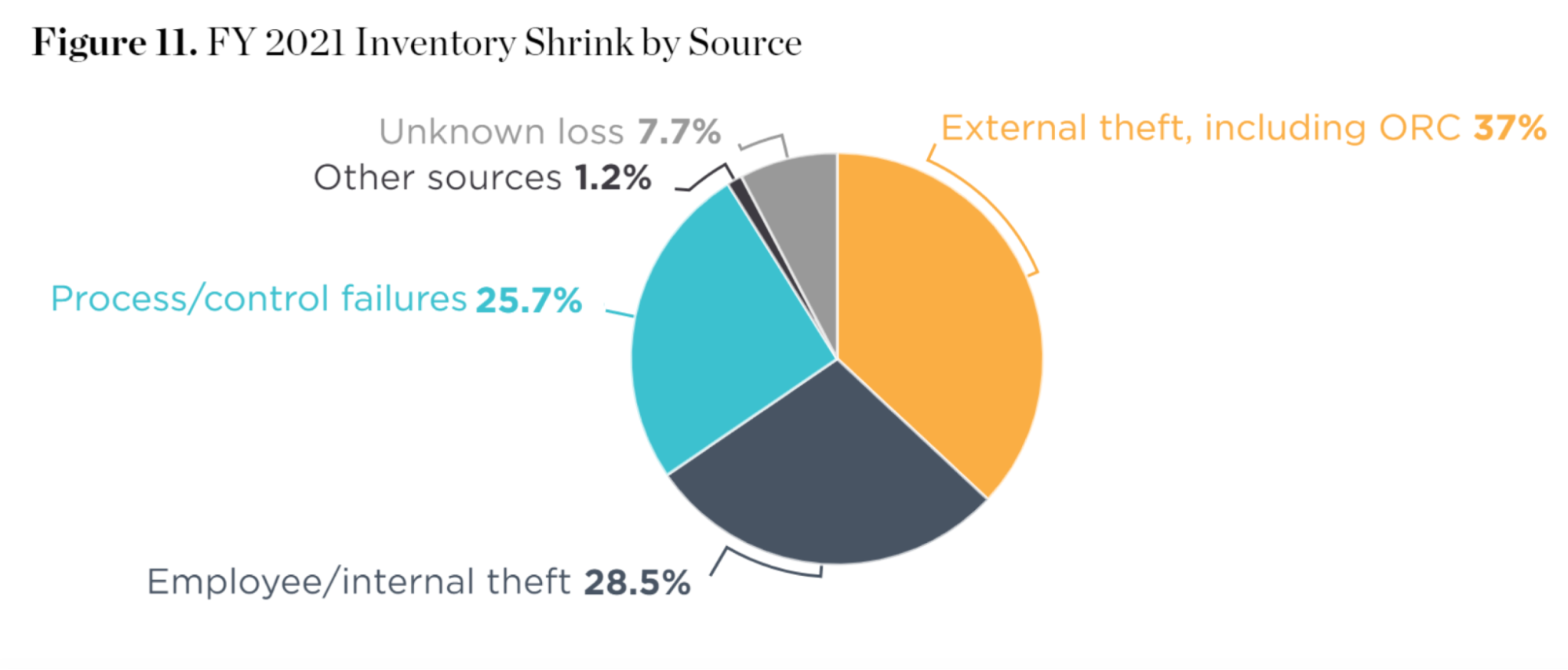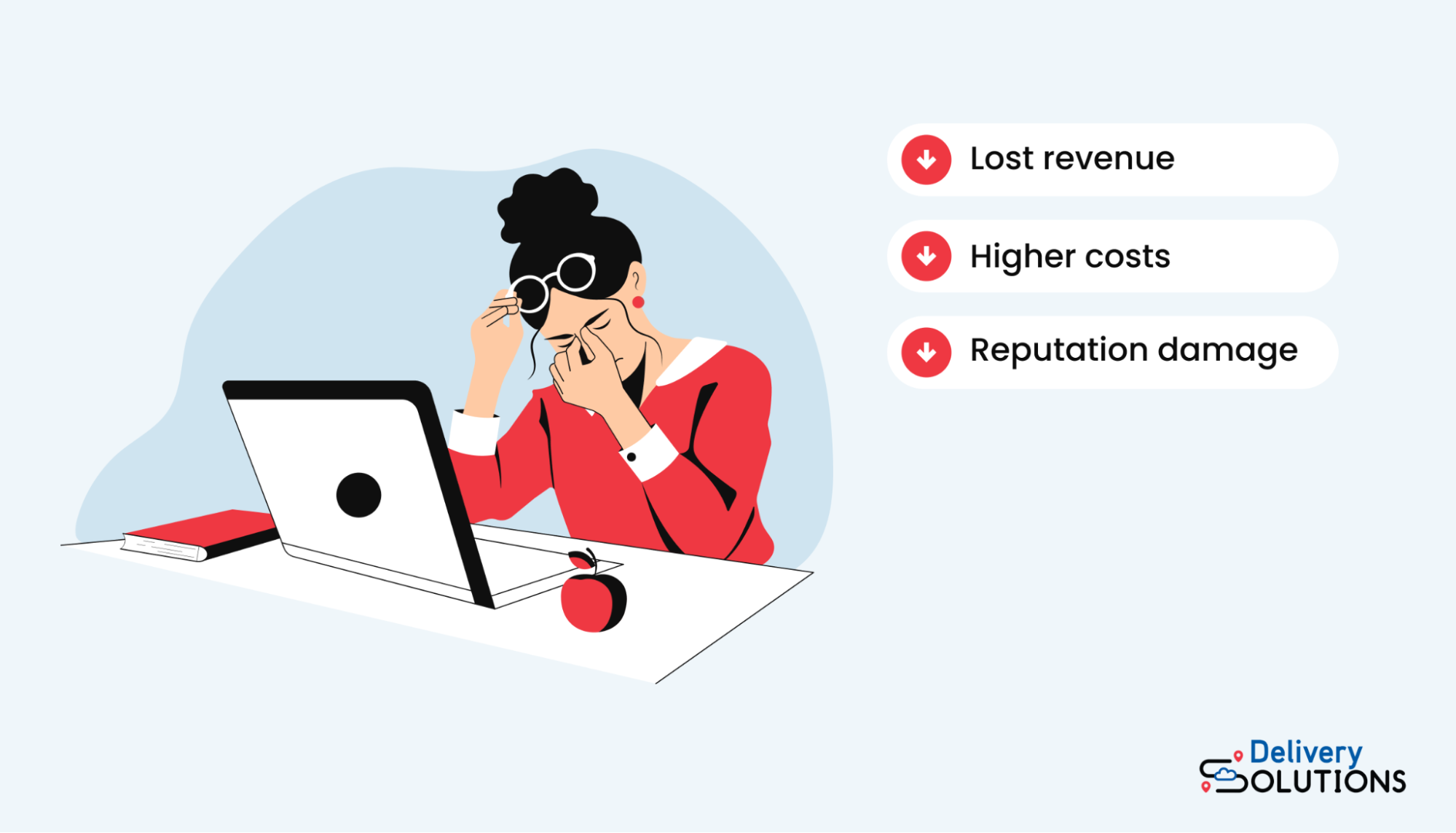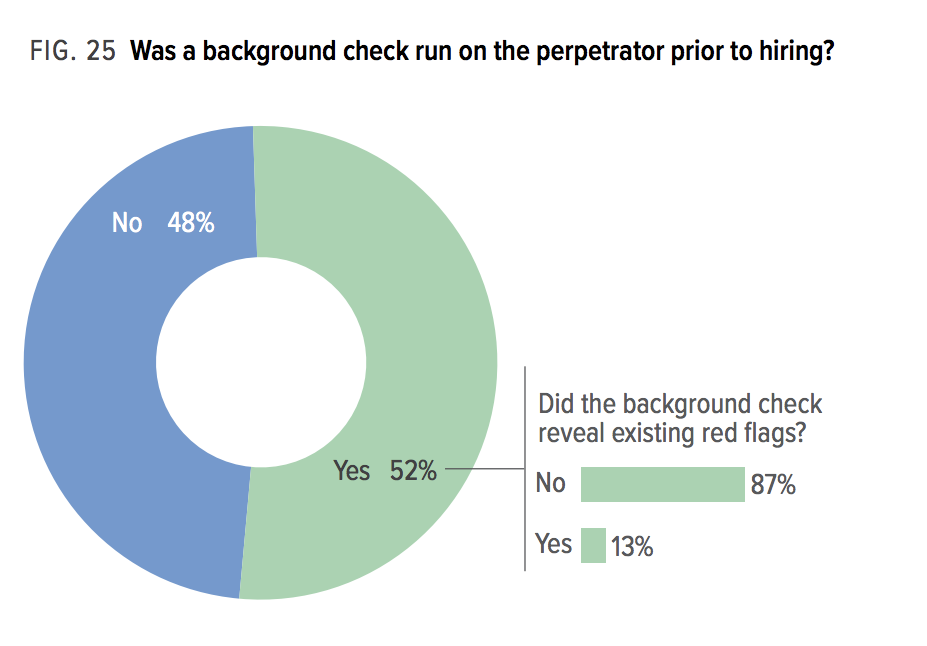Retail shrinkage is a serious issue for retailers. Shrinkage is the loss of inventory caused by factors like theft, damage, fraud, or operational errors.
In 2021, the cost of shrinkage grew to nearly $95 billion — up nearly $5 billion from the year before. In an industry like retail, where margins are already often razor-thin, losing revenue to shrinkage isn’t something to be taken lightly.
Retailers must be vigilant in identifying and addressing these issues to mitigate losses and protect their businesses.
In this article, we’ll explore the different causes of retail shrinkage, how it robs retailers of profits, and we’ll provide you with actionable strategies to reduce or prevent it. Whether you’re a small business owner or a large retailer, understanding and addressing shrinkage is critical to the success of your business.
What does retail shrinkage look like?
Retail shrinkage is the loss of inventory or merchandise, which causes a discrepancy between the recorded inventory and the actual inventory on hand. To put it simply, it’s inventory that should be there, but isn’t.
The loss of inventory isn’t attributed to sales, but to other causes such as theft, damage, or even simple administrative errors.
For example, suppose your store receives $10,000 worth of inventory at the beginning of the month, which you record in your books. By the end of the month, you’ve made $8,000 worth of sales, but your inventory count reveals you’ve got only $1,000 worth of inventory left.
Where did the other $1,000 go? The answer is shrinkage. After investigating, you determine that $800 of the missing inventory was lost due to shoplifting and the other $200 was damaged.
Shrinkage can have a significant impact on retailers’ bottom line, resulting in lost revenue and reduced profits. Shrinkage and profits are directly correlated — the higher the shrinkage, the lower the profits. While shrinkage can’t be completely eradicated, it’s in your company’s best interest to identify it, prevent it and manage this profitability vampire.
How to calculate retail shrinkage
Understanding how to calculate shrinkage is a fundamental but critical concept in the retail industry. Retail shrinkage is usually expressed as a percentage of company sales:

Retail shrinkage % = (Recorded Inventory - Actual Inventory) / Recorded Inventory
In the previous example, the recorded inventory was $10,000, but $1,000 of it was lost to shrinkage, resulting in a retail shrinkage of 10%. In the real world, this number is incredibly high, which means the store would need to take immediate measures to manage and reduce shrinkage.
Shrinkage is a normal cost of business, if it's kept under control
It’s next to impossible to entirely avoid shrinkage in retail. While there isn’t an “ideal” shrink percentage in retail, the average shrinkage rate for most retailers is between 1–2% of total sales. The lower you can get this number, the better.
According to the National Retail Federation’s (NRF) annual survey, the average shrink rate in 2021 was 1.44%, a slight decrease from the last two years but comparable to the five-year average of 1.5%. This number may seem insignificant, but for big e-commerce retailers, even a 1–2% shrinkage rate can account for millions in losses.
The main causes of shrinkage
Understanding why shrinkage happens is the first step to managing and reducing it. Here are the most common causes of shrink in retail.
Theft
According to the NRF survey’s participating retailers, external and internal theft were the biggest causes of shrinkage, accounting for 65.5% of all inventory loss.

External theft, including shoplifting and organized retail crime (ORC), are the main culprits. ORC is a growing issue for both retailers and the industry at large, involving theft, fraud, and even violence. Retailers report that organized retail offenders have become more violent in the last few years, and employee safety is one of their main priorities.
The top retail categories targeted by ORC include apparel, health and beauty, electronics and appliances, and food and beverage.
Employee theft is another leading cause of shrinkage plaguing retailers. Dishonest employees cut into profits by stealing merchandise or accepting fake returns.
Administrative errors
Administrative errors that involve paperwork and other operational missteps can also contribute to retail shrinkage. These errors usually occur when a transaction is processed, merchandise is received or shipped, or inventory is taken. Common administrative errors include:
- Inaccurate inventory counts
- Accounting errors
- Incorrect pricing
- Paperwork mismanagement
Most administrative mistakes are caused by human error and can be easily avoided by automating various systems, including inventory management.
Fraud
In-store and e-commerce fraud is a major source of loss in the retail and e-commerce retail industry. Over 60% of retailers reported that e-commerce fraud increased in 2021 and 53.9% reported an increase in omnichannel fraud.

While e-commerce retailers don't have to worry about in-store theft, there are many ways customers engage in cyber-fraud activities, including credit card fraud and identity theft. Fraudsters can also make a purchase on one channel and initiate a fraudulent return on a different one to bypass some of the screening processes that would otherwise detect their scheme.
Vendor fraud can also lead to shrinkage, though it’s a lot less common. This occurs when suppliers or vendors overcharge or underdeliver on products. For example, a vendor may deliver a cheaper variant of inferior quality of a product than what the retailer ordered.
Inventory damage
Accidental damage to inventory stock can also lead to shrinkage. For example, merchandise is sometimes mishandled during transportation, or damaged due to environmental factors such as humidity or temperature.
Since the damaged products can’t be sold in the market, they’re considered inventory shrinkage and waste products.
3 ways shrinkage affects retailers
Shrinkage is an unfortunate reality for today’s retailers. If not managed properly, or worse — ignored, it can have significant negative effects on retailers.

1. Lost revenue
When a retailer loses inventory through shrinkage, there’s no way to recoup those losses. Once the inventory is gone, so is the potential revenue that could have been generated from those extra sales. Eventually, these losses trickle down to a retailer’s bottom line.
In an industry like retail, where profit margins are already razor thin, shrinkage can have a huge effect on a company’s profitability. To offset these losses, some retailers try to pass the shrinkage costs on to customers by raising their prices. Price increases can turn cost-sensitive customers away, which further affects profits and affects customer lifetime value.
2. Higher costs
Retailers incur additional costs to prevent or address a shrinkage problem. For example, they may need to invest in theft prevention technology like surveillance cameras or pay for theft prevention employee training.
If a large part of shrinkage is due to employee theft, employers will have to launch an investigation into internal shoplifting, which can also be costly and use up extra resources.
3. Reputation damage
Retail shrinkage can also damage a retailer’s reputation.
If businesses make up for lost profits by cutting costs in other areas of the business, the ripple effect may be huge. This can take the form of staff lay-offs, which puts a strain on the remaining staff. Employees may feel demotivated and demoralized if shrinkage undermines their efforts, which can lead to a higher turnover.
A high shrinkage rate can also cause suspicion among staff, vendors, third-party service providers, and even customers. The strained relationships between these parties lead to a lost trust.
7 ways to mitigate and prevent retail shrinkage
Retailers need to take steps to prevent revenue shrinkage and mitigate its effects to maintain a healthy and profitable business.
1. Implement retail loss prevention technology
As new retail risks continue to emerge, retailers must leverage new technologies to mitigate those risks. NRF survey participants reported they were planning on investing in shrink-prevention technologies such as RFID systems and AI-based point-of-sale (POS) or self-checkout video analytics.
RFID, or radio frequency identification technology, has various uses in retail, including maintaining inventory records or identifying and recovering stolen merchandise. AI-based video analytics can help detect in-store theft such as ticket- or product-switching.
2. Automate inventory management
Using inventory management software such as order management systems (OMS) can provide retailers with the tools they need to prevent shrinkage. For example, automating inventory checks instead of spreadsheets can significantly improve the accuracy of inventory counts and reduce the risk of human-made errors

Retailers can also quickly identify discrepancies between what’s on the shelf and what’s recorded in the inventory system. This allows them to quickly resolve issues before they become bigger problems.
3. Conduct regular inventory audits
Inventory audits are an important part of a good shrinkage prevention strategy. Regularly conducting audits from time to time ensures appropriate stock levels and helps identify any missing, damaged, or stolen inventory.
The knowledge that regular inventory audits are conducted can act as a deterrent to employees who might be tempted to steal or mismanage inventory. This can help prevent shrinkage before it even occurs.
If you suspect internal theft is a growing problem in your retail store, conducting unannounced, “surprise” inventory audits can be used as a tactic to find discrepancies in your stock without giving employees a warning.
4. Run rigorous background checks and know your employees
As we’ve seen from the NRF survey, employee theft is the second biggest cause of retail shrinkage. One way to mitigate internal theft is to run thorough background checks before hiring, to ensure you’ve done your due diligence.
A background check can include employment history, criminal records, reference checks, education verification, or anything else that can uncover red flags. Unfortunately, not enough businesses do this.
A recent survey found that only half of employers who have experienced employee fraud have done their due diligence. And out of those who did, 13% hired the perpetrator despite the initial red flag warning.

Getting to know your employees and observing changes in behavior is also very important. According to the survey, behavioral red flags to look for include living beyond their means, financial difficulties, unusual closeness to a vendor, or an unwillingness to share duties.
5. Invest in a loss prevention team
If shrinkage is a growing issue in your retail business, having a dedicated department to manage and reduce it can be a worthwhile investment.
Walmart’s loss prevention team, or Asset Protection specialists, provide security and ensure compliance in their stores and distribution centers. Their goal is to provide a safe experience for both shoppers and employees by implementing various security measures and reducing customer theft and fraud.
And with ORC and violence towards employees on the rise, having a designated security team can help reduce and prevent these incidents.
6. Offer multiple pickup and delivery options
If you’re an e-commerce retailer, consider offering customers multiple pickup options such as in-store pickup, in-store storage lockers, or curbside pickup. These solutions enable customers to control exactly when and where they want to pick up online orders, preventing theft or loss. As a bonus, it would also save you from having to pay additional shipping costs.
You can also give customers the option to order online and have the product shipped to an alternative location that isn’t your physical store or their home. These alternative delivery locations are called access points, and they can be anything from a UPS store, or a partnered location like a drugstore.
Retail shrinkage can be prevented and mitigated in a few ways, all orchestrated and organized by Delivery Solutions’ unified omnichannel experience software. This includes solutions like in-store pickup, storage lockers, curbside pickup, or delivery to convenient access points.
7. Manage omnichannel fraud
Omnichannel fraud is becoming a major source of loss for the retail industry, since fraudsters use multiple online channels (i.e., e-commerce websites, social media platforms, and mobile apps) to commit their crimes.
As an e-commerce retailer, it’s important to find ways to prevent it. Using tactics like cross-channel tracking or multi-factor authentication can help minimize shrinkage originating from omnichannel fraud.
For example, by tracking fraud across all channels, you can block fraudsters from your entire business once they’re discovered. This can be achieved with the help of software that tracks customer behavior and consumption patterns. The insights gathered from customers can help you identify suspicious activity that would otherwise be overlooked by human oversight.
Start building a shrink prevention strategy
For retailers, shrinkage is an inevitable part of doing business. However, it’s crucial that you take action to prevent and control shrinkage before it starts eating into your profits.
Create a solid shrinkage prevention plan and invest in the right software and solutions to curb inventory loss. An effective shrinkage prevention plan could save you millions in losses, reduce costs associated with shrinkage, and keep your customers and employees happy.
Schedule a demo today to discover how Delivery Solutions can help you mitigate retail shrinkage.
Ryan Caldarone
Ryan is a Sr. Digital Marketing Manager with over ten years of experience in B2B eCommerce, specializing in brand storytelling and content. Having contributed to hundreds of creative projects for SMBs and startups across the tech, energy, and fine arts sectors, Ryan brings diverse perspectives.
Topics from this blog: Solutions Retail Management Efficiency
